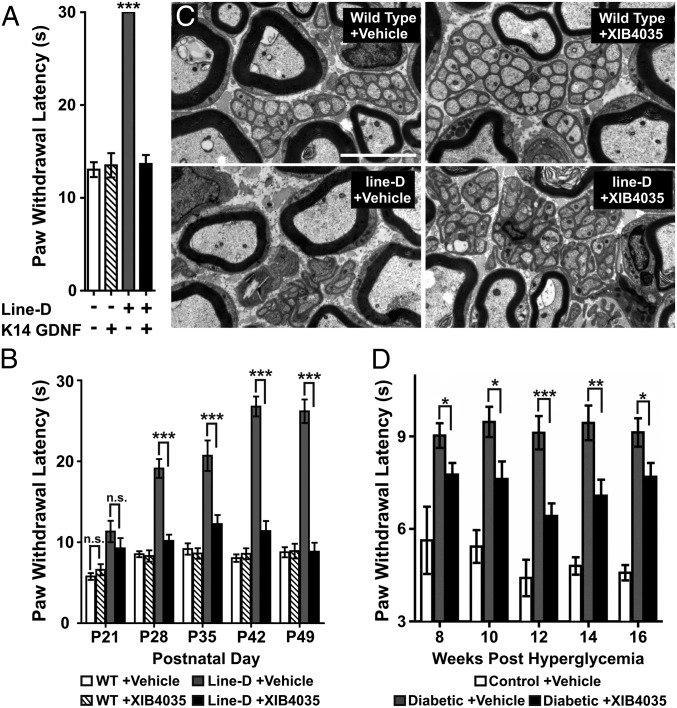Fig. 1.
Overexpression of GDNF in the skin or topically applied XIB4035 curtails progression of SFN in two animal models. (A) Hot-plate (54 °C) test shows that the loss of thermal nociception in line-D mice is prevented by GDNF overexpression in keratinocytes (K14-GDNF). Only responses of line-D differ from those observed in the other three genotypes (one-way ANOVA with Newman–Keuls post hoc test, n ≥ 3; ***P < 0.001; error bars indicate SEM). (B) Hot-plate (54 °C) test shows that XIB4035 treatment starting at P21 prevents loss of thermal nociception in line-D mice. Wild-type (WT) and line-D mice were randomly divided into two groups at P21, a stage at which line-D mice had a small but significant increase in paw withdrawal latency compared with WT animals (Student t test, P = 0.0002). No difference existed within the groups of each genotype (Student t test, n ≥ 6; WT +vehicle vs. WT +XIB4035, P = 0.3067; line-D +vehicle vs. line-D +XIB4035, P = 0.285). Line-D mice treated with vehicle had progressively longer withdrawal latencies over the duration of the treatment. In contrast, WT mice treated with either vehicle or XIB4035, and XIB4035-treated line-D mice had similar latencies throughout the duration of the treatment. For P28, P35, P42, and P49: one-way ANOVA with Newman–Keuls post hoc test, n ≥ 6; WT +vehicle vs. line-D +vehicle (P < 0.001), WT +vehicle vs. line-D +XIB4035, n.s., line-D +vehicle vs. line-D +XIB4035 (P < 0.001); error bars indicate SEM. (C) Electron micrographs of transverse sections from the sciatic nerve of line-D mice treated for 4 wk (P49) show that Remak bundle structure is lost in mutants treated with vehicle but preserved in line-D mice treated with XIB4035. Remak bundle structure in wild types is not changed by the treatment. (Scale bar: 4 μm.) (D) Modified Hargreaves test show that XIB4035 treatment improves thermal nociception in diabetic mice. STZ-injected mice were treated with either XIB4035-containing cream or vehicle from onset of hyperglycemia. Hindpaw thermal response latency was measured every other week from week 8 posthyperglycemia onward. At week 8, vehicle-treated diabetic (diabetic +vehicle) mice showed thermal hypoalgesia (P < 0.01 vs. control +vehicle by ANOVA with Newman–Keuls post hoc test) that was attenuated by XIB4035 treatment (*P < 0.05 for diabetic +vehicle vs. diabetic +XIB4035; n ≥ 7; error bars indicate SEM) but not completely normalized (P < 0.05 for control +vehicle vs. diabetic +XIB4035). The attenuation of paw thermal hypoalgesia persisted throughout the study (*P < 0.05, **P < 0.01, ***P < 0.001, for diabetic +vehicle vs. diabetic +XIB4035 mice: one-way ANOVA with Newman–Keuls post hoc test; error bars indicate SEM).

